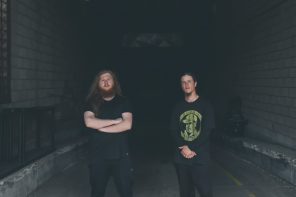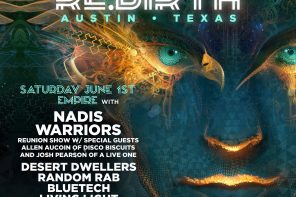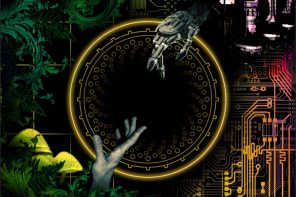As if the accelerating pace of the 21st Century were not enough, I am starting to suspect that the common notion of time as frantic but comfortably linear is hopelessly naïve – that in order to adequately navigate our postmodern lives, we need a postmodern understanding of causality. The more I look, the more I find a growing body of evidence that time – both as it is experienced and as it is disclosed by science – is best understood as more of a loom than a river. Gathered here are just a few of the many independent programs that suggest that our ideas of cause and effect need to be drastically reworked.
Exhibit A: The Global Consciousness Project at Princeton University has discovered that the noise of the quantum vacuum occasionally organizes itself into very non-random patterns right before events of planetary emotional significance. As just one of many examples, their global grid of random number generators registered a massive spike of orderly activity that peaked during the 9/11 attacks…but started over four hours before the attacks occurred. A similar global spike of statistically unlikely quantum orderliness occurred the day of Barack Obama’s presidential inauguration.
These “disturbances in the Force” are registered by the Global Consciousness Project’s psychic seismometers hours in advance…but don’t provide enough resolution (yet) for us to understand what forthcoming event might be triggering them, so they remain fairly useless as predictive data. Nonetheless, the deeper message is profound: the world somehow “knows” what is going to happen before we do.
Exhibit B: Three independent groups of researchers (Half Past Human is getting the most press, for those curious enough to investigate) who each programmed web bots to mine the emotional valences of words and phrases in websites and online forums, thereby creating “forecasts” of upcoming events. The theory behind this information age divination is that whether we realize it or not, everyone has precognitive capacities, and even the most ignorant among us are unconsciously affected by something right before it happens. Whatever part of the brain that lets dogs know when their owners have decided to come home, or tells wild animals to run for high ground when a tsunami is coming, still exists within the human organism; we’ve just drowned it out with the noise of our urban electronic environments. Most indigenous societies claim to still be in touch with this part of themselves, by the way.
So with web bot-driven speculative linguistics, if a flood is about to happen, for example, the “flood meme” will appear more frequently in our conversations. By analyzing the mass changes in how we use language, these groups have been able to predict with uncanny clarity a meteor strike and a terrorist attack on a dam, among other things.
Of course, exactly where and when these things are due to happen remains elusive. The data sets churned out by this software read like the I Ching, and each group humbly reminds us that their process is something like trying to map the skies by poking pinholes in a sheet. But we might be witnessing the beginnings of a revolution in our understanding of cause and effect.
In light of these projects, one has to wonder: Are we making the future, or just stumbling into it? I think a better question is, “Why does it have to be one or the other?” We already have plenty of evidence that our brain stems select relevant information and provide what Robert Anton Wilson called “reality tunnels” (no doubt related to the kind with light at the end of them) chiseled out of a billion times more sense data than we ever experience. By giving attention to something, our dutiful brain stems learn to fetch it for us without us even having to ask. Eventually the world becomes whatever we’ve been looking for.
There is no sure way to say that everything else – the world beyond our reality tunnels – does or does not exist. But since some kind of information apparently goes backward in time, it seems reasonable to suggest that we’re steering ourselves toward something that already exists.
After all, we have to acknowledge the pragmatic validity of those ideas that “stand the test of time” – and no matter how hard it tries, modernism cannot make every culture in the world give up the archetype of the Seer. What more, those societies most associated with psychic revelations of the future have – think back to those web bot surveys – a different language for time than those “stuck on linear.” The Hopi (who famously described the dropping of the atom bomb – a “gourd of ash” – thousands of years ago) have no words, grammar, or expressions that refer to past, present, future, or the passage of time. Hindi, the language of innumerable sages, has only one word for both yesterday and tomorrow. Adjacent in the ranks is time theorist Julian Barbour, who argues that quantum equations only make sense when expressed in a timeless space containing every possible present – a world of all moments unequivocally agreed upon by mystics and psychedelic pioneers the world over.
Since we can only know the world through our own senses (and, indirectly, the reports of other people), there’s no way to distinguish between selecting a future and creating it…but either way, there’s little denying that the future is somehow folded into this moment.
So it seems to me like the most satisfactory explanation is that the future is already “out there,” and we’re also creating it…or at least collectively steering ourselves toward the one of all possible futures that cries out to us the loudest. As we march on into the 21st Century, the 21st Century marches on into us.
If the future and present are co-responsible for each other, then we can extend this weirdo logic to its conclusion: also, the present made the past that made the present. We are not only more at the mercy of our future than we have learned to believe; we are also more responsible for our past than has ever been comfortable to admit. To put it another way: time, in its common sense of the passage of time, can be plainly defined as any two or more eternal static moments shaking hands. You and I are the shaking…a cosmic chord, if you don’t mind listening sideways.
Understanding time as a relational process between moments, it might behoove us to release the simplistic notion of either destiny or fate as an absolute. The paradoxical prescription is to both take more responsibility for this moment – the only moment, after all, in which “past” and “future” really exist – and to surrender a little more deeply when the world we inherit from both past and future does not meet our prideful assumptions of control (since the present, after all, only exists as the intersection of past and future). We are neither dashed about by fate, nor are we masters of our own destiny. But we are able to agree with one another about which visions we will give our attention and energy, which stories of origin and outcome we wish to cultivate right now. We are both cause and effect.
—
For Michael’s academic treatment on a multimethodological science of time, read “Integral Time & Causality.”
You can explore how Michael expresses these ideas in his art at his blog, The Love Without End Tour Diary.







